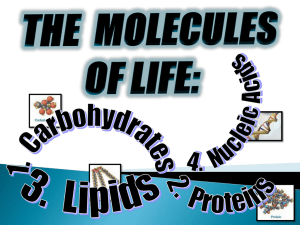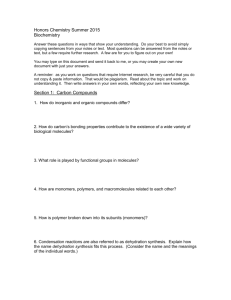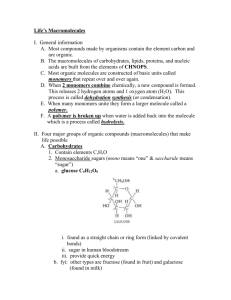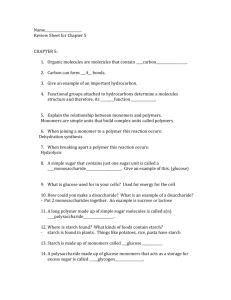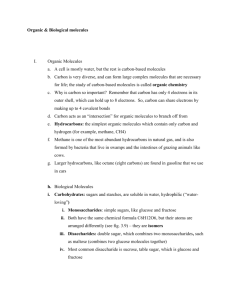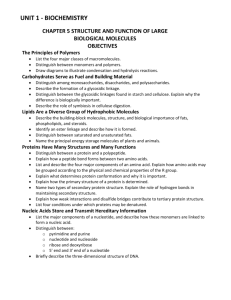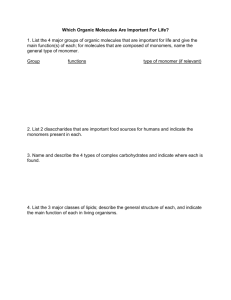Ester linkage
advertisement
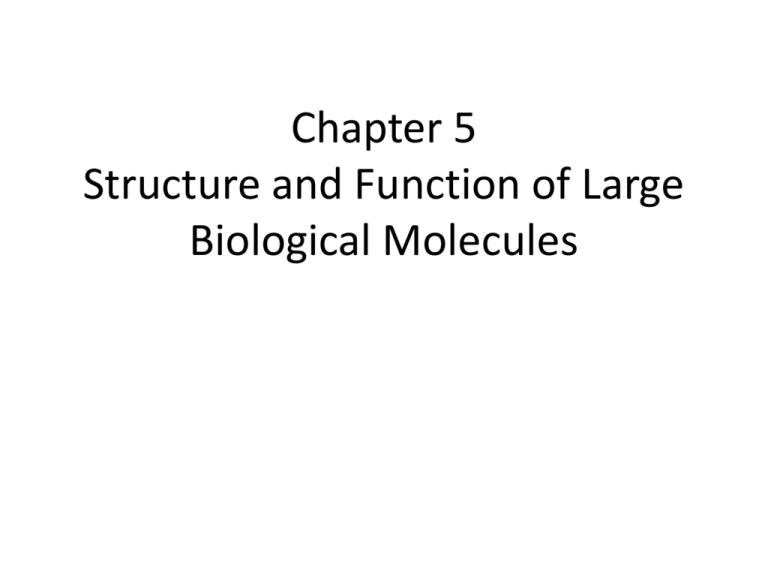
Chapter 5 Structure and Function of Large Biological Molecules What are the Molecules of Life? – Because life is so complex, we would assume that there are numbers of molecules – This is not the case • The large molecules of all living things fall into four main clases – – – – Carbohydrates Lipids Proteins Nucleic acids What are macromolecules? – Huge – Molecules that are very large and complex – Exhibit unique emergent properties due to the orderly arrangement of their atoms What are polymers? – Chain-like molecules – Long molecule consisting of many similar or identical building blocks linked by covalent bonds – Macromolecules in three of the four classes of life’s organic compounds • Carbohydrates • Proteins • Nucleic acids What are monomers? – Repeating units that serve as the building blocks of a polymer – Smaller molecules What’s different about the polymers? • Classes of polymers differ in the nature of their monomers What’s similar about the polymers? – The chemical mechanisms by which cells make and break down polymers are basically the same in all cases What is a condensation reaction? – Monomers are connected by this type of reaction – Two molecules are covalently bonded to each other through loss of a water molecule What is a dehydration reaction? – A specific condensation reaction – Because water is the molecule that is lost – When a bond forms between two monomers, each monomer contributes part of the water molecule that is lost • One molecule provides a hydroxyl group (-OH) • The other provides a hydrogen (- H) – Reaction can be repeated as monomers are added to the chain one by one, making a polymer – Facilitated by enzymes • Specialized macromolecules that speed up chemical reactions in cells What is hydrolysis? – Polymers are disassembled to monomers through this process – Reverse of dehydration reaction – Means “to break using water” – Bonds between the monomers are broken by the addition of water molecules • Hydrogen from water attaching to one monomer • Hydroxyl group attaching to the adjacent monomer What is an example of hydrolysis? • Digestion Dehydration and Hydrolysis Reactions Short polymer Unlinked monomer Dehydration removes a water molecule, forming a new bond Longer polymer Dehydration reaction in the synthesis of a polymer Hydrolysis adds a water molecule, breaking a bond Hydrolysis of a polymer Dehydration reactions in Carbohydrates Dehydration reaction in the synthesis of maltose 1–4 glycosidic linkage Glucose Glucose Dehydration reaction in the synthesis of sucrose Maltose 1–2 glycosidic linkage Glucose Fructose Sucrose There exists great diversity within macromolecules: – Between one cell to another • Even in same organism – Between siblings variations exist – Between unrelated individuals • More and more extensive differences exist What is the basis for this diversity? – Macromolecules are constructed from only 40 to 50 common monomers – Example: • Proteins are built from only 20 kinds of amino acids arranged in chains that are hundreds of amino acids long – SMALL MOLECULES COMMON TO ALL ORGANISMS ARE ORDERED INTO UNIQUE MACROMOLECULES What is a carbohydrate? – Include both sugars and polymers of sugars – Three forms • Monosaccharide • Disaccharide • Polysaccharide What is a monosaccharide? – Simplest of carbohydrates – Known as simple sugars – From Greek monos (meaning single) and sacchar (meaning sugar) – Have molecular formulas that are some multiple of the following unit: • CH2O What is a monosaccharide? • Example: –C6H12O6 –The most common monosaccharide –Of central importance to the chemistry of life –Aldose What is the structure of a sugar? • Has carbonyl group – >C=O • multiple hydroxyl groups – - OH Carbohydrates See the Carbonyls and Hydroxides? Dehydration reactions in Carbohydrates Dehydration reaction in the synthesis of maltose 1–4 glycosidic linkage Glucose Glucose Dehydration reaction in the synthesis of sucrose Maltose 1–2 glycosidic linkage Glucose Fructose Sucrose What distinguishes between sugars? – Can be either aldose (aldehyde sugar) or ketose (ketone sugar) – Can also classify sugars by the size of the carbon skeleton – Can also be diversified based on spatial arrangement What distinguishes between sugars? – Can be either aldose (aldehyde sugar) or ketose (ketone sugar) • Glucose is an aldose What distinguishes between sugars? – Can be either aldose (aldehyde sugar) or ketose (ketone sugar) – Can also classify sugars by the size of the carbon skeleton • Ranges from 3 to 7 carbons long • Examples: – Hexoses » Glucose and fructose » Have six carbons – What’s an example of a triose? – What’s an example of a pentose? What distinguishes between sugars? – Can be either aldose (aldehyde sugar) or ketose (ketone sugar) – Can also classify sugars by the size of the carbon skeleton – Can also be diversified based on spatial arrangement • Arrangement around asymmetrical carbon • Example: – Glucose and galactose differ in placement of parts around asymmetrical carbon – This small difference gives those carbons different shapes and behaviors What’s the biological importance of monosaccharides? – In cellular respiration, energy is extracted in series of reactions from glucose – Simple sugars are major source of energy for cells What is a disaccharide? – Double sugars – Consist of two monosaccharides joined by a glycosidic linkage What is glycosidic linkage? – Covalent bond formed between two monosaccharides by dehydration reaction – Example: • Maltose is disaccharide formed by inking of two molecules of glucose – Maltose is also know as a malt sugar – Used in brewing beer • Sucrose – Table sugar – Monomers that make up it are glucose and fructose What is a polysaccharide? – Polymer composed of many sugar building blocks? – Macromolecules – Polymers with few hundred to a few thousand monosaccharides joined by glycosidic linkages – Some serve as storage material that are hydrolyzed as needed to provide sugar for cells What is a storage polysaccharide? – Used for storage for later use – Starch Starch • Plant polysaccharide • Two forms – Amylose (unbranched) – Amylopectin (branched) • Plants store starch as granules within cellular plastids – Include chloroplasts • Polymer of glucose monomers • Allows the buildup (stockpile) of surplus glucose – Represents stored energy • Most glucose monomers are jointed by 1 – 4 linkages – #1 carbon to #4 carbon Starch • Sugar can later be withdrawn from this carbohydrate “bank” hydrolysis – Breaks the bonds between the glucose monomers • Animals also have enzymes that can hydrolyze plant starch Light ovals in the micrograph are granules of starch within a chloroplast of a plant cell. Simplest form of starch is the amylose. Amylopectin is more complex starch Glycogen • Polymer of glucose similar to polysaccharide but very branched • Humans store this in liver and muscle cells • Hydrolysis releases glucose when the demand for sugar increases • Cannot sustain an animal for long • Stores are depleted in about a day unless they are replenished by consumption of food What is a structural polysaccharide? – Build strong materials from structural polysaccharides – Example: • Cellulose Cellulose in Plant Cell Walls Cellulose microfibrils in a plant cell wall Cell walls Microfibril 0.5 µm Plant cells Cellulose molecules b Glucose monomer Cellulose • • • • • Major component of the cell walls in plant cells Most abundant organic compound on earth Polymer of glucose Different glycosidic linkage than those in starch Glucose monomers are in beta configuration – Every other glucose monomer is upside down • Never branched • Some hydroxyl groups on its glucose monomers are free to hydrogen – bond • In plant cell walls, parallel cellulose molecules held together arranged into microfibrils Cellulose • Enzymes that digest starch by hydrolyzing its alpha linkages cannot hydrolyze the beta linkages of cellulose • Humans cannot digest cellulose – Some animals possess enzymes that can digest cellulose • Some prokaryotes can digest cellulose – In cows and termite guts Chitin • Another structural polysaccharide • Carbohydrate used by arthropods to build exoskeleton • Leathery and flexible – Becomes hardened when encrusted with calcium carbonate • Found in many fungi • Glucose monomer of chitin has a nitrogencontaining appendage Chitin What are Lipids? • Class of large biological molecules • Does not include true polymers • Not big enough to be considered macromolecules • Grouped together because share one important trait • Mix poorly with water – Hydrophobic • Consist mostly of hydrocarbon regions • Vary in form and function Lipids Lipids • Include waxes and certain pigments • Most biologically important types: – Fats – Phospholipds – steroids What are fats? • Not polymers • Large molecules assembled from few smaller molecules • Dehydration reactions • Constructed from 2 kinds of smaller molecules – Glycerol – Fatty acids What are fats? • Major function of fats is energy storage • 1 gram of fat stores more than tice as much energy as a gram of polysaccharide (like starch) • Stored in adipose cells What is a glycerol? • Alcohol with 2 carbon skeleton bearing hydroxyl group What is a fatty acid? • Has a long carbon skeleton – Usually 16 or 18 atoms in length • Carbon at end of fatty acid is part of carboxyl group – What gives it the name fatty acid • Attached to the carboxyl group is a long hydrocarbon chain • Nonpolar C – H bonds in the hydrocarbon chains of fatty acids are the reason fats are hydrophobic Ester Linkage and Lipids Fatty acid (palmitic acid) Glycerol Dehydration reaction in the synthesis of a fat Why do fats separate from water? • Water molecules hydrogen-bond to one another and exclude the fats • Three fatty acid molecules each join to glycerol by an ester linkage when making a fat – Also called a triacylglycerol What is an ester linkage? • Bond between a hydroxyl group and a carboxyl group Triglycerol molecule Ester linkage What is a triacylglycerol? • Consists of three fatty acids linked to one glycerol molecule • Also called a triglyceride Fatty Acids • Vary in length • Vary in number and locations of double bonds What is a saturated fat? • No double bonds between carbon atoms composing the chain • As many hydrogen atoms as possible are bonded to the carbon skeleton • Saturated with hydrogens • At room temperature, the molecules of a saturated fat such as butter are packed closely together • saturated fatty acids • Fat made from saturated fatty acids • Flexibility allows fat molecules to pack together tightly What is a saturated fat? • Lard • Butter Saturated vs. Unsaturated What is an unsaturated fat? • Has one or more double bonds • Formed by the removal of hydrogen atoms from the carbon skeleton • At room temperature, molecules of an unsaturated fat such as olive oil cannot pack together closely enough to solidify • the kinks in some of their fatty acid hydrocarbon chains wherever a cis double bond occurs • Kinks prevent molecules from packing closely What is an unsaturated fat? • Fats of plants and fishes • Referred to as oils Saturated vs. Unsaturated What are hydrogenated oils? • Unsaturated fats synthetically converted to saturated fats by adding hydrogen • Examples: – Peanut buter – Margarine – Keep from separated What are trans fat? • Through hydrogenating vegetable oils produces not only saturated fats but also unsaturated fats with trans double bonds • May contribute to atherosclerosis What are phospholipids? • • • • • • Type of lipid Essential for cells Make up cell membranes Similar to fat molecule Has only two fatty acids attached to glycerol Third hydroxyl group of glycerol is joined to phosphate group • Has a negative electrical charge • Small molecules can be linked to the phosphate group to form a variety of phospholipids Phospholipid of cell membranes What are phospholipids? • Two ends show different behavior toward water • Tails are hydrophobic • Hydrophilic head • Self-assemble into double-layered aggregates – bilayers What are steroids? • Lipids characterized by a carbon skeleton consisting of four fused rings • Vary in chemical group attached Steroid Structure What are cholesterol? • Common component of animal cell membranes • Precursor from which other steroids are synthesized • Synthesized in liver in vertebrates • Hormones: – Sex hormones – Steroids produced from cholesterol Proteins • Account for more than 50% of dry mass of most cells • Instrumental in almost everything organisms do • Some speed up chemical reactions, some play role in structural support, storage, transport, cellular communication, movement, and defense against foreign substances • Most structurally sophisticated molecules known • Vary in structure • Have unique 3D shape • Consists of one or more polypeptides What do Proteins do? • Some speed up chemical reactions • some play role in structural support, storage, transport, cellular communication, movement, and defense against foreign substances Proteins What are enzymes? • Most are proteins • Regulate metabolism by acting as catalysts • Can perform its function over and over again What are catalysts? • Chemical agents that selectively speed up chemical reactions without being consumed by the reaction What are polypeptides? • Polymers of amino acids • 20 different polypeptides construct amino acids • Polypeptides are folded and coiled into a specific 3D structure What are Amino Acids? • Share common structure • Organic molecules possessing both carboxyl and amino groups • At center, is an asymmetric carbon called alpha carbon • 4 different partners: – Amino group – Carboxyl group – Hydrogen atom – Variable group (R) LE 5-UN78 a carbon Amino group Carboxyl group Amino Acid Partners • Amino and carboxyl are in ionized form because that’s how they usually exist in the pH in a cell • R group: – R group can be a simple hydrogen atom or a carbon skeleton with various functional groups – The physical and chemical properties of this side chain determines the unique characteristics of a particular amino acid – Affects the functional role in a polypeptide – Grouped according to properties of side chains Nonpolar – Hydrophobic Amino Acids Hydrophilic Amino Acids Acidic vs Basic Amino Acids Acidic have side chains that are generally negative in charge. Basic amino acids have side chains that are generally positive in charge. REFERS ONLY TO THE SIDE CHAINS Amino Acid Polymers • Amino acids become positioned so that carboxyl group of one is adjacent to amino group of the other • Joined by dehydration reaction – Creates a peptide bond • POLYPEPTIDE – Polymer of many amino acids linked by peptide bonds – Range in length from few monomers to thousand or more Dehydration and Hydrolysis Reactions again Short polymer Unlinked monomer Dehydration removes a water molecule, forming a new bond Longer polymer Dehydration reaction in the synthesis of a polymer Hydrolysis adds a water molecule, breaking a bond Hydrolysis of a polymer What are the N- and C- termina? • N-terminus – Amino end of the chain • C-terminus – Carboxyl end of the chain • The repeating sequence of amino group, carbon, and carboxyl group is called the polypeptide backbone Peptide Bonding Diversity • The ability to make different polymers by linking the 20 amino acids into a variety of sequences Protein structure • Its activities depend on its 3D shape • Polypeptide DOES NOT EQUAL Protein • Functioning protein is not just 1 polypeptide chain but, instead, one or more polypeptides twisted, folded and coiled into a molecule with a unique shape Protein structure • Once the polypeptide is formed, it will spontaneously fold into the 3D shape • The folding pattern is reinforced by the formation of bonds between different parts of the chain • Some are spherical (globular proteins) • Some are long fibers (fibrous proteins) Protein structure • Specific structure determines how it works • Function is dependent on ability to recognize and bind to another molecule Why is this important for enzymes? • Must recognize and bind closely to its substrate (substance that the enzyme works on) • Lock and key • Example: – Endorphins • Heroin and morphine mimic endorphins BUT… it all depends on the primary structure 4 Levels of Protein Structure • Primary • Secondary • Tertiary • Quaternary Primary Structure • The amino acid sequence • Primary structure is determined by inherited genetic information Primary (1’) sequence Secondary • Segments of polypeptide chains that are coiled or folded • Coils and folds are result of hydrogen bonds between the parts of the polypeptide backbone – due to electronegative N and O with partial negative charge – Slightly positive H attracted to O of nearby atom What are the 2 types of secondary structures? • a helix – Delicate coil – Held together by hydrogen bonds btw every 4th amino acid • B pleated sheet – 2 or more regions of polypeptide side chain are connected by hydrogen bonds btw parts of the 2 parallel polypeptide backbones 2’ structure Tertiary Structure • Represented by overall shape of polypeptide • Results from interactions between the side chains of the Amino Acids • Hydrophobic interaction with van der Waals interactions – While folding into functional shape, the AA with hydrophobic (nonpolar) side chains end up clustered together in core of protein – Caused by water – Van der Waals interactions then hold them together • This with the hydrogen bonds between polar side chains and ionic bonds help stabilize further Tertiary Structure • Those with the hydrogen bonds between polar side chains and ionic bonds help stabilize further • Reinforced by covalent bonds in disulfide bridges between Two cysteine monomers – Sulfhydryl group of one is brought close to another with protein folding 3’ Structure Quaternary Structure • 2 or more polypeptide chains in one functional macromolecule • Overall protein structure • Example – Collagen 4’ Structure Sickle –Cell Anemia • Slight change in primary structure • Substitution of 1 AA • Blood cells are then sickle-shaped instead of disk-shaped • Hemoglobin molecules tend to crystallize Sickle Cell and Oxygen transport Sickle-cell hemoglobin Normal hemoglobin Primary structure Val His 1 2 Leu Thr 3 4 Pro Glu 5 6 Secondary and tertiary structures 7 b subunit Quaternary Normal hemoglobin structure (top view) Primary structure Secondary and tertiary structures Molecules do not associate with one another; each carries oxygen. His Leu Thr Pro Val Glu 1 2 3 4 5 6 7 Exposed hydrophobic region b subunit a Quaternary structure b Val b a Function Glu Sickle-cell hemoglobin b a Function Molecules interact with one another to crystallize into a fiber; capacity to carry oxygen is greatly reduced. b a Protein’s Natural Form What can cause proteins to unravel? • Changes in natural: – pH – Salt concentration – Temp – Environmental alterations – Changed from an aqueous environment to organic solvent • Hydrophobic regions face outward – Disruptions in hydrogen bonds, ionic bonds, and disulfide bridges – Excessive heat What is denaturation? • Biologically inactive • Unraveling • Losing native shape Denaturation of a protein Not as simple as it looks • Intermediate stages exist from primary to quaternary structure • Chaperonins – Chaperone proteins – Proteins that assist in proper folding of other proteins – Keep protein from “Bad influences” Chaperonin What happens when there is a misfolding? • Alzheimer’s • Parkinson’s How do we see the 3D structures? • X-ray crystallography • Bioinformatics • NMR spectroscopy What determines the Primary Structure? • Amino Acid sequence is programmed by gene What is a gene? • Unit of inheritance • Consist of DNA What is DNA? • A polymer made up of nucleic acids What is a Nucleic Acid? • Class of compounds • Enable organisms to reproduce their complex components from one generation to the next • Two types of nucleic acids exist – Deoxribonucleic acids (DNA) – Ribonucleic acid (RNA) DNA • Provides direction for its own replication • Directs RNA synthesis RNA • Directs protein synthesis DNA • Genetic material organisms inherits from parents • Each chromosome contains one long DNA molecule – Carries several hundred genes • Copied and passed from one generation to next when cell reproduces itself by dividing • Contains the information that programs all the cell’s activities • Reside in nucleus DNA • NOT directly involved in running operations of cell… • INSTEAD, directs RNA synthesis which directs Protein synthesis • Protein are required to implement genetic programs and they are the tool for biological functions RNA • Each gene along a DNA molecules directs synthesis of type of RNA – called messenger RNA (mRNA) Messenger RNA • mRNA • Interacts with cell’s protein-synthesizing machinery and directs production of polypeptide DNA -> RNA -> protein Where does protein synthesis take place in the cell? • Ribosomes – In cytoplasm in eukaryotic cells What is a Nucleic Acid? • Macromolecules that exist as polymers called polynucleotides What is a polynucleotide? • Made up of monomers of nucleotides • The strand of nucleotides What is a nucleotide? • Three parts: – Nitrogenous base – 5-Carbon Sugar (pentose) – Phosphate group What is a nucleoside? • Nucleotide without the phosphate group • Two parts: – Nitrogenous base – 5-Carbon Sugar (pentose) How to build a nucleotide? • Two types: – Pyrimidines – Purines How to build a nucleotide? • Two families of nitrogenous bases: – Pyrimidines • 6- membered ring of carbon and nitrogen atoms • Examples: – Cytosine ( C ) – Thymine ( T ) – Found only in DNA – Uracil ( U ) – Found only in RNA How to build a nucleotide? • Two types: – Pyrimidines – Purines • Larger • 6-membered ring fused to 5-membered ring • Examples: – Adenine ( A ) – Guanine ( G ) How to build a nucleotide? • The examples differ in chemical groups attached to the rings – Pyrimidines – Purines Why called nitrogenous bases? • Nitrogen atoms tend to take up H+ from solution What is the difference between RNA and DNA? • Ribose sugar in RNA • consist of a single polynucleotide chain • Deoxyribose sugar in DNA – Lacks oxygen atom on second carbon in the ring Describing Nucleotide • Nitrogenous base and sugar both numbered • Sugar atoms have a prime (‘) after the number to distinguish How do you build a polynucleotide? • Link nucleotides with phosphodiester linkage – Phosphate group that links the sugars of two nucleotides • Sugar-phosphate backbone • Two free ends are different • One end has phosphate attached to 5’ carbon – 5’ end • Other end has hydroxyl group on 3’ carbon – 3’ end • Built - in directionality -> from 5’ to 3’ Diversity • From 4 DNA bases and with sequences of bases that are hundred to 1000 bases long, vast arrangement of genes exist • Linear order of bases in a gene specify amino acid sequence DNA Double Helix • DNA molecules have two polynucleotides that spiral around an imaginary axis • James Watson and Francis Crick 1st proposed the double helix as the 3D structure of DNA in 1953 • Run antiparallel (5’ -> 3’ direction from each other) • Sugar Phosphate backbone on outside • Nitrogenous bases paired on interior DNA Double Helix • Polynucleotides are held together by hydrogen bonds between paired bases • Polynucleotides are held together by van der Waals interactions between the stacked bases • Very long • 1000s and millions of bases How do bases pair? • A–T • G–C • Sequence of bases along one strand would give you the sequences of bases along the other strand • Two strands are complementary • Ex: 5’ – AGGTCCG – 3’ 3’ – TCCAGGC – 5’ DNA Replication • Each of two strands of DNA molecule serves as a template to order nucleotides into a new complementary strand • Results in two identical copies of the original double-stranded DNA molecule Tape Measure of Evolution • Hemoglobin

